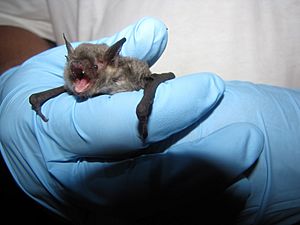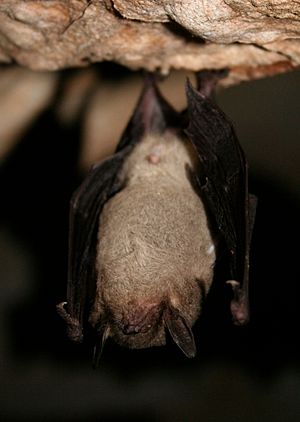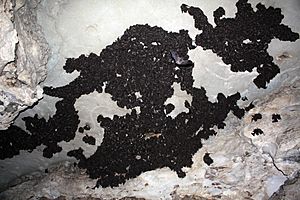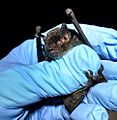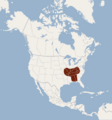Gray bat facts for kids
Quick facts for kids Gray bat |
|
|---|---|
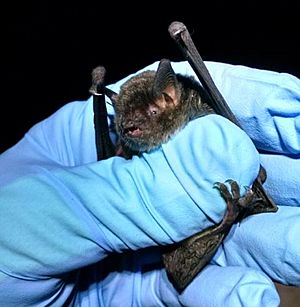 |
|
| Conservation status | |
| Scientific classification | |
| Genus: |
Myotis
|
| Species: |
grisescens
|
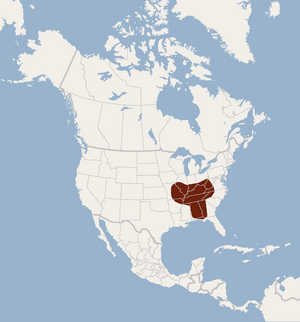 |
|
| Approximate range of the gray bat (2009) | |
The gray bat (Myotis grisescens) is a type of microbat found only in North America. These bats once lived in many caves across the southeastern United States. However, human activities caused their numbers to drop a lot during the 1900s. Today, about 95% of all gray bats live in just 11 caves.
The U.S. Fish and Wildlife Service listed the gray bat as an endangered species in 1976. This means it is protected by the Endangered Species Act. When they were first listed, there were about 2 million gray bats. By the early 1980s, their population fell to 1.6 million. Thanks to conservation efforts, the gray bat population grew to an estimated 3.4 million by 2004.
Contents
What Does a Gray Bat Look Like?
Gray bats are the largest bats of their genus (Myotis) in the eastern United States. They depend on caves more than almost any other U.S. mammal. Their fur is dark gray on their backs. After they molt (shed their fur) in July or August, their fur might look more reddish-brown.
Unlike other Myotis bats, the gray bat's wing membrane connects to its ankle, not its toe. Gray bats usually weigh between 7 and 16 grams. They can live up to 17 years, but only about half of them survive to become adults. They are ready to have babies around age 2.
A gray bat's forearm is only about 40–46 millimeters long. If a gray bat's forearm is shorter than 39.5 millimeters, it cannot fly. When migrating, gray bats fly at about 20.3 kilometers per hour (12.61 mph). When they are looking for food, they can fly between 17 and 39 kilometers per hour.
Gray bats shed their fur every year between early June and early August. During this time, they eat more hair than usual. When they groom themselves, they also eat tiny bugs called chiggers that live in their fur. Bats likely groom a lot before they start hunting each night. Then, they spend the night hunting and digesting their food.
Where Do Gray Bats Live?
Gray bats live in areas with limestone caves, called karst areas. These areas are found in states like Alabama, Arkansas, Kentucky, Missouri, Tennessee, and parts of Florida, Georgia, Kansas, Indiana, Illinois, Oklahoma, Mississippi, and Virginia.
Gray bats are "cave obligate" bats. This means they almost always live in caves. They do not live in old barns or other buildings like some other bat species. Less than 5% of all available caves are used by gray bats. This means that any disturbance to these special caves can be very harmful to their populations.
Different Caves for Different Seasons
The largest summer groups of gray bats are found in the Guntersville Reservoir area in Alabama. This area has caves like Sauta and Hambrick, which can hold over 100,000 gray bats. Gray bats use caves differently throughout the year.
In the fall, many gray bats gather in caves called hibernacula to get ready for winter sleep (hibernation). In the spring, they spread out. Females form "maternity colonies" (summer nurseries) where they raise their young. Males and young bats that are a year old gather in "bachelor colonies." Gray bats also use "dispersal caves" only when they are migrating.
For their winter homes, gray bats like deep, cool caves. These caves usually have temperatures between 5 and 11 degrees Celsius. They also prefer caves with many entrances and good airflow. Summer caves are often found near rivers. They are warmer, with temperatures between 14 and 25 degrees Celsius. These caves often have natural "heat traps" like domed ceilings. These traps help keep the heat from the clustered bats inside, which is important for the baby bats. Summer caves are usually within 1 kilometer of water and rarely more than 4 kilometers from a large river or lake. Gray bats like to roost very close together, with about 1828 bats per square meter.
Gray Bat Behavior and Life Cycle
How Gray Bats Find Food
Gray bats hunt for food over water, like streams and reservoirs. They eat night-flying insects, many of which have young stages that live in water. They also hunt in the forests near these water sources. Gray bats prefer to hunt over slower-moving water or quiet pools. They usually fly below the tops of trees but above 2 meters from the ground.
Gray bats tend to fly downstream more often than upstream. This might be because downstream areas are wider. Gray bats hunt over large areas, usually about 12.5 kilometers, but sometimes as far as 35.4 kilometers.
When there is plenty of food, gray bats might hunt in small groups. But when food is scarce, they can become territorial. Female bats that are having babies often claim the same hunting areas year after year.
What Gray Bats Eat
Gray bats eat many kinds of insects. These include beetles, flies, mayflies, moths, net-winged insects, caddis flies, and stoneflies. Young bats tend to hunt more in woodlands and eat more beetles than adult bats. Beetles give them more energy for the effort it takes to catch them. For example, beetles provide 1900–2800 calories per gram, while mayflies provide 800–1400 calories per gram. Young bats also eat a less varied diet than adults. This might be because young bats need to find large groups of prey.
Scientists think gray bats are both opportunistic (eating whatever they find) and selective (choosing certain foods). In the wild, they are limited by when their prey appears. When insects emerge, there are only a few types available at any time. The types of insects change depending on the time of night, the month, and the season. In their natural habitats, gray bats seem to attack any moving insect that is the right size. This fits with the idea that they should eat tasty insects when they find them.
However, in labs, bats use echolocation to tell the difference between prey based on shape and texture. This might not happen as much in the wild because bats fly fast. They only have a split second to catch prey after they find it. Still, gray bats do seem to choose certain insects in the wild. They eat more moths, beetles, flies, and sometimes caddis flies than would be expected if they just ate whatever was available. Because they choose some prey while also being opportunistic, gray bats are called "selective opportunists." Scientists believe food moves quickly through a gray bat's body. They get rid of waste within 1–2 hours after eating.
Migration, Hibernation, and Reproduction
Gray bats migrate in the fall in a similar order to how they leave their winter caves in the spring. Females leave first in early September, and young bats leave last in mid-October. Gray bats can travel as far as 500 kilometers (310 miles) from their summer caves to reach their hibernation caves. Gray bats are active from April to October, but female bats start hibernating in September.
After arriving at their winter caves, mating happens. Females go into hibernation right away. Males might stay active for a few more weeks. They use this extra time to build up their fat reserves that they used during mating. Males start hibernating by early November.
During hibernation, a gray bat's body temperature drops to be close to the cave's temperature. This helps them save fat. These fat reserves must last for about six months of hibernation and spring migration. Many adult bats die during spring migration if they do not have enough fat. They struggle to survive the stress and energy needed for the journey.
After mating, females store the male's sperm in their uterus. They only release an egg after they come out of hibernation. Pregnancy in gray bats lasts 60 to 70 days. Babies are born in late May and early June. Female gray bats usually give birth to one baby per year. The baby bat clings to its mother for about a week. After that, it stays in the maternity colony until it can fly. Most young bats can fly by four weeks of age (late June to mid-July).
Energy Use and Growth
Like other living things, gray bats use energy to grow and maintain their bodies. Once they can have babies, much of their energy goes into reproduction. Gray bats prefer caves near good hunting spots. This helps them save energy by not flying long distances to find food.
Gray bats roost in large groups to save energy on keeping warm. Female bats need to stay warm when they are feeding their babies, even though the cave is cool. This takes a lot of energy. When babies are about 20–30 days old, mothers might spend up to 7 hours a night feeding. Large roosts are helpful for females because they can share the effort of staying warm.
However, there is a downside to very large colonies. As the group gets bigger, bats have to compete more for food. This forces individual bats to hunt over a larger area, which uses more energy. This extra energy use can slow down the growth of young gray bats. Studies show that the farther a gray bat flies to find food, the less it will weigh. This supports the idea that long flights use a lot of energy.
Threats to Gray Bats
Gray bats gather in large groups, which makes them very vulnerable to problems caused by humans. Their habitats have become more separate and broken up because of human activities. Things that have hurt gray bat populations include:
- Building dams, which can flood caves.
- Making caves into tourist attractions.
- Natural floods.
- Pesticides.
- Water pollution and siltation (dirt settling in water).
- Cutting down forests nearby.
All North American bat species listed as endangered or threatened by the U.S. Fish and Wildlife Service live in caves. Of these, the gray bat gathers in larger numbers in fewer winter caves than any other North American bat. About 95% of gray bats hibernate in just 11 caves. A large number, 31%, hibernate in one single cave in northern Alabama. Because so many gray bats live in specific places, they are an important "indicator species." This means their health can show how well conservation efforts are working.
Pesticide Use and Gray Bats
The use of pesticides has been a major reason for the decline of gray bat populations. One study looked at gray bats in the Tennessee River area of northern Alabama. Scientists noticed more gray bats dying there than usual. Since 1947, large amounts of chemicals like DDTR (which includes DDT) flowed into waterways from a DDT factory. This polluted the bat habitats and the local wildlife.
Deadly amounts of DDT were found in the brains of adult bats. These levels were about 1.5 times higher than in young bats. Since gray bats eat many insects whose young stages live in water, scientists believe this food source is where the chemicals come from. Many young bats tested could not fly, so they likely only drank milk. If their mothers ate contaminated insects, the chemicals could become concentrated in the milk. This could then kill the young bats.
When bats use up their fat reserves quickly, like during migration or when young bats start flying, harmful chemicals stored in their fat can be released into their bodies, causing death. Other pesticides like dieldrin and aldrin have also been linked to gray bat deaths. Even though DDT production stopped in 1970 and dieldrin/aldrin production stopped in 1974, heavy pollution continued for a long time.
However, recent samples of guano (bat droppings) from different habitats show a decrease in some harmful chemicals. For example, guano from Cave Springs cave showed a 41% drop in DDE (a chemical related to DDT) between 1976 and 1985. Guano from Key Cave showed a 67% drop in the same period. But it is still unknown how long these chemicals will remain at harmful levels for wildlife.
Human Disturbance and Gray Bats
Direct human disturbance and vandalism are major reasons for the decline of gray bat populations. In the 1960s, people killed bats for fun as they left caves. Some people also caught bats for pranks. Many property owners tried to kill whole colonies because they wrongly feared the bats carried rabies.
Bats that roost (sleep) within 100 meters inside a cave and only 2 meters above the floor are most at risk from vandalism and disturbance. Bats that roost higher up or deeper inside the cave are safer. One study showed that caves with ceilings higher than 15 meters were almost safe from cavers.
Even without direct harm, human visits to caves can hurt gray bat populations. Every time a person enters a cave, any bats within range of light or sound will at least partly wake up from hibernation. Waking up during hibernation makes gray bats use up energy. This lowers their energy reserves. Since these reserves must last through hibernation and spring migration, if a bat runs out of energy, it might leave the cave too early. This lowers its chances of survival. Each disturbance during hibernation is estimated to use energy that could have kept a gray bat alive for 10–30 days of undisturbed hibernation. When young bats cannot fly (in June and July), mothers escaping a predator or other disturbance might drop their babies in a panic. This leads to more young bats dying.
Protecting Gray Bats
Using Cave Gates
Many things are important for a good gray bat habitat. These include the cave entrance, the cave's physical features, and the weather outside. These factors help create the right conditions inside the cave for bats. Because gray bats live in caves, their range is limited to caves with good internal conditions. Human actions have greatly reduced the number of suitable caves for gray bats.
To help gray bats, the United States government is funding programs to put gates on caves. Cave gating is a good way to protect cave-dwelling animals. It limits how much humans disturb the cave's internal conditions. When building gates inside caves, several important things are considered. The gates are designed to not change the airflow too much. They also make sure bats can easily fly in and out.
These gates are placed 5 to 15 meters before important bat roosting areas. Also, there is a 15-centimeter space between the bars of the gate. This allows bats to fly through without problems. Early cave gating methods did not consider these factors, which often caused bats to abandon the caves.
To see if cave gating works, scientists look at bat populations before and after the gates are built. They also watch when bats leave the cave. Population numbers are estimated by how much bat guano (droppings) builds up. More guano means more bats. Scientists use infrared light to watch bats leaving caves. Observations show that gates do not stop bats from leaving.
However, gated entrances can sometimes create new opportunities for natural predators of gray bats. Gates might make bats fly slower, and they can give predators places to perch near the cave entrance. This means that natural predation might increase because of cave gating.
Protecting Bat Populations
In their 1982 Gray Bat Recovery Plan, the U.S. Fish and Wildlife Service outlined steps to stop the decline of gray bat populations and protect their habitats. The plan suggested buying caves where gray bats live. At these locations, human access would be limited to prevent disturbance. To reduce human impact, methods like gating, fencing, putting up signs, and law enforcement surveillance can be used.
Since gray bats use different caves depending on the season, protection efforts should focus on the right caves at the right time. Rivers, lake shores, and forests near gray bat caves should be left untouched. This ensures bats have enough places to find food. Any activity within 25 kilometers of a major gray bat cave, such as using pesticides or herbicides, clearing land, or anything that might cause siltation, should be carefully reviewed. Government officials and landowners with gray bat caves should learn about gray bats and activities that could harm them. Finally, the U.S. Fish and Wildlife Service recognized the need for ongoing scientific research to better understand how humans affect this vulnerable species.
Legal Status of Gray Bats
In the western part of the gray bat's range, from 1978 to 2002, populations in 21 out of 48 (44%) maternity caves showed an increase. 17 caves (35%) showed no clear trend, and 10 caves (21%) showed a decrease. A study in 2003 looked at gray bat populations in summer caves across the entire species range. This study found that out of 76 maternity colonies, 3 (4%) were increasing, 66 (87%) showed no clear trends, and 7 (9%) were decreasing.
The Endangered Species Act says that 90% of the most important winter caves must be protected. Also, populations in 75% of the most important maternity colonies must be stable or increasing for 5 years. If these goals are met, the gray bat could be moved from endangered to threatened status.
Because the gray bat's range is so large, and sampling techniques have been varied and incomplete, it is hard to get perfectly reliable data for a species-wide count. So, gray bats are unlikely to be downgraded soon. However, their total population has grown by about 104% between the 1980s and 2004 (from 1.6 million to 3.4 million).
After 37 years with no gray bats seen in Mississippi, a male gray bat was found on September 20, 2004. It was in Tishomingo County in northeastern Mississippi. This was 42 kilometers south of where gray bats were last known to live in the state before they disappeared. Before this 2004 discovery, the only known gray bats in Mississippi lived at a place called Chalk Mine. They were last seen there in 1967. A lot of human disturbance, including trash, smoke, and graffiti, is believed to have affected the bats' use of Chalk Mine.
While finding this bat is a good sign for conservationists, it is possible the bat did not come from a Mississippi gray bat population. The closest known gray bat maternity colony is at Blowing Springs Cave, Alabama, which is 90 kilometers northeast of where the 2004 bat was found. Since gray bats are known to hunt over large areas, it is possible this bat belonged to the Blowing Springs Cave colony.
Images for kids



